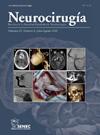Marcadores metabolómicos electrolíticos, de gases y el medio interno en el hematoma subdural crónico
IF 0.8
4区 医学
Q4 NEUROSCIENCES
引用次数: 0
Abstract
Background and objective
Chronic subdural hematoma is one of the most common diseases in neurosurgical practice. The content of electrolytes and gases in the collection could participate in the growth and expansion mechanism, however, there is no evidence that they have been studied before. The objective has been to identify electrolyte, gas and internal metabolomic markers of the content of chronic subdural hematomas, with the possibility of participating in their growth and expansion and to substantiate a pathophysiological hypothesis that interacts with existing ones.
Material and method
A descriptive study was carried out with 53 patients operated on for chronic subdural hematoma at the «Roberto Rodríguez Fernández» General Teaching Hospital of Morón in Ciego de Ávila, Cuba, in the period between January 2019 and December 2023. The diagnoses were obtained with computed axial tomography. The electrolyte and blood gas components of hematomas are correlated with clinical and neuroimaging variables.
Results
Patients over 70 years of age predominated (37 [69.81%]) and males (38 [71.70%]). The Markwalder scale upon admission showed a predominance of Grade III in 24 cases (45.28%). The Glasgow outcome scale showed a predominance of Grade V (31 cases [58.49%]).
Conclusions
Electrolyte and gasometric metabolomic markers of subdural blood can promote the phenomenon of progressive growth and expansion and have a synergistic effect with the rest of the pathophysiological mechanisms.
慢性硬膜下血肿的电解、气体和内部环境代谢标志物
背景与目的慢性硬膜下血肿是神经外科最常见的疾病之一。收集液中电解质和气体的含量可能参与了生长和膨胀机制,但目前尚无研究证据。目的是鉴定慢性硬膜下血肿内容的电解质、气体和内部代谢组学标记物,以及参与其生长和扩张的可能性,并证实与现有假设相互作用的病理生理学假设。材料和方法在2019年1月至2023年12月期间,在古巴Ciego de Ávila的Morón«Roberto Rodríguez Fernández»综合教学医院对53例慢性硬膜下血肿患者进行了描述性研究。诊断通过计算机轴位断层扫描获得。血肿的电解质和血气成分与临床和神经影像学变量相关。结果70岁以上患者占37例(69.81%),男性占38例(71.70%)。入院时Markwalder量表显示III级优势24例(45.28%)。格拉斯哥预后量表显示V级优势(31例[58.49%])。结论硬膜下血电解质和气体代谢组学指标能促进大鼠进行性生长和扩张现象,并与其他病理生理机制具有协同作用。
本文章由计算机程序翻译,如有差异,请以英文原文为准。
求助全文
约1分钟内获得全文
求助全文
来源期刊

Neurocirugia
医学-神经科学
CiteScore
1.30
自引率
0.00%
发文量
67
审稿时长
60 days
期刊介绍:
Neurocirugía is the official Journal of the Spanish Society of Neurosurgery (SENEC). It is published every 2 months (6 issues per year). Neurocirugía will consider for publication, original clinical and experimental scientific works associated with neurosurgery and other related neurological sciences.
All manuscripts are submitted for review by experts in the field (peer review) and are carried out anonymously (double blind). The Journal accepts works written in Spanish or English.
 求助内容:
求助内容: 应助结果提醒方式:
应助结果提醒方式:


